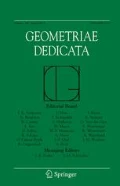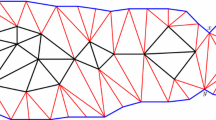Abstract
The hexagon is the least-perimeter tile in the Euclidean plane. On hyperbolic surfaces, the isoperimetric problem differs for every given area. Cox conjectured that a regular k-gonal tile with 120-degree angles is isoperimetric for its area. We prove his conjecture and more.


Similar content being viewed by others
Availability of data and materials
The manuscript has no data.
References
Bezdek, K.: Ein elementarer Beweis für die isoperimetrische Ungleichung in der Euklidischen und hyperbolischen Ebene. Ann. Univ. Sci. Budapest. Eötvös Sect. Math. 27, 107–112 (1984)
Carroll, C., Jacob, A., Quinn, C., Walters, R.: On generalizing the Honeycomb theorem to compact hyperbolic manifolds and the sphere. Report of SMALL Geometry Group’06, Williams College (Aug. 2006). https://sites.williams.edu/Morgan/ongeneralizing-the-honeycomb-theorem-to-compact-hyperbolic-manifolds-and-thesphere/
Choe, J.: On the existence and regularity of fundamental domains with least boundary area. J. Differ. Geom. 29(3), 623–663 (1989). https://doi.org/10.4310/jdg/1214443065
Cox, C.: The Honeycomb problem on hyperbolic surfaces (Aug. 2005). https://sites.williams.edu/Morgan/the-honeycomb-problem-on-hyperbolic-surfaces/
Cox, C.: The Honeycomb problem on hyperbolic surfaces (July 2011). https://sites.williams.edu/Morgan/the-honeycomb-problem-on-hyperbolic-surfaces/
Di Giosia, L., Habib, J., Hirsch, J., Kenigsberg, L., Li, K., Pittman, D., Petty, J., Xue, C., Zhu, W.: Optimal monohedral tilings of hyperbolic surfaces. arXiv e-prints arXiv:1911.04476 [math.MG] (Nov. 2019)
Edmonds, A.L., Ewing, J.H., Kulkarni, R.S.: Regular tessellations of surfaces and (p, q, 2)-triangle groups. Ann. Math. 116(1), 113–132 (1982)
Edmonds, A.L., Ewing, J.H., Kulkarni, R.S.: Torsion free subgroups of Fuchsian groups and tessellations of surfaces. Bull. Am. Math. Soc. 6(3), 456–458 (1982). https://doi.org/10.1090/S0273-0979-1982-15014-5
Edmonds, A.L., Ewing, J.H., Kulkarni, R.S.: Torsion free subgroups of Fuchsian groups and tessellations of surfaces. Invent. Math. 69(3), 331–346 (1982). https://doi.org/10.1007/BF01389358
Hales, T.C.: The Honeycomb conjecture. Discrete Comput. Geom. 25(1), 1–22 (2001). https://doi.org/10.1007/s004540010071
Klein, F.: Ueber die Transformation siebenter Ordnung der elliptischen Functionen. Math. Ann. 4, 428–471 (1878). https://gdz.sub.uni-goettingen.de/download/pdf/PPN235181684_0014/PPN235181684_0014.pdf. Trans. by Silvio Levy as “On the order-seven transformation of elliptic functions.” In: The Eightfold Way: The Beauty of Klein’s Quartic Curve. Vol. 35 (1998). Chap. 9, pp. 287–331. http://library.msri.org/books/Book35/files/klein.pdf
Šešum, V.: The Honeycomb Problem on Hyperbolic Surfaces. Undergraduate Thesis. Williams College (May 2006). https://sites.williams.edu/Morgan/the-honeycombproblem-on-hyperbolic-surfaces-by-vojislav-sesum/
Tóth, L.F.: Regular Figures. Vol. 48. International Series of Monographs on Pure and Applied Mathematics. The Macmillan Company, New York (1964)
Tóth, L.F.: Über das kürzeste Kurvennetz das eine Kugeloberfläche in flächengleiche konvexe Teil zerlegt. Mat. Term. tud. Ertesitö 62, 349–354 (1943)
Tóth, L.F.: What the bees know and what they do not know. Bull. Am. Math. Soc. 70(4), 468–481 (1964)
University of Glasgow. Hyperbolic Area—Heron’s Formula. https://www.maths.gla.ac.uk/wws/cabripages/hyperbolic/harea2.html
Acknowledgements
This work is a product of the 2019 Summer Undergraduate Mathematics Research program at Yale (SUMRY) under the guidance of Frank Morgan of Williams College. The authors greatly thank Morgan for his help and insight over the many weeks spent researching and writing this paper. We thank the Young Mathematicians Conference (YMC) and Yale for supporting our trip to present at the 2019 YMC in Columbus, Ohio.
Funding
The research was supported by 2019 Summer Undergraduate Mathematics Research program at Yale (SUMRY).
Author information
Authors and Affiliations
Corresponding author
Ethics declarations
Conflict of interest
All authors declare that they have no conflict of interest.
Code availability
The manuscript has no code.
Additional information
Publisher's Note
Springer Nature remains neutral with regard to jurisdictional claims in published maps and institutional affiliations.
Rights and permissions
About this article
Cite this article
Hirsch, J., Li, K., Petty, J. et al. Certain hyperbolic regular polygonal tiles are isoperimetric. Geom Dedicata 214, 65–77 (2021). https://doi.org/10.1007/s10711-021-00605-2
Received:
Accepted:
Published:
Issue Date:
DOI: https://doi.org/10.1007/s10711-021-00605-2




